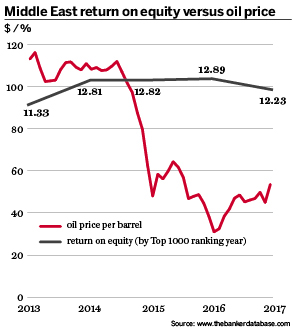This year’s rankings suggest the oil price collapse has not had the catastrophic effect on the Middle East's banks that had been predicted
One of the most striking takeaways from this year’s Top 1000 is the Middle East’s resilience to the collapse in oil prices. The oil rout began in 2014 but fears for its banks took hold early in 2016 when the price per barrel dipped below $30.
Credit rating agencies responded by downgrading sovereigns and banks across the region, while oil-dependent governments slashed spending, funding costs increased and more borrowers became at risk of default. Analysts predicted turmoil for banks in the Gulf states, warning about lower profitability, higher non-performing loans (NPLs) and impairment charges, a liquidity crunch and resultant industry consolidation.
But this year’s rankings suggest that the oil price collapse has not had the catastrophic effect predicted. Regional aggregate profits slid 4.4% from 2015, but are still higher than 2014 and 2013, when oil hovered around the $100 per barrel mark. Regional ROA is flat at 1.51%, while ROE is 12.23% – more than double that of western Europe. By almost every measure, the Middle East was more profitable in 2016 than four years prior.
Analysing the region’s biggest banking and oil-exporting markets shows the trend also holds up on a national level. From 2013 to 2016, Saudi Arabian banks’ profits have grown 9.8% while those of the United Arab Emirates and Qatar are up 26.6% and 20.8%, respectively. Kuwait and Bahrain have also increased returns in the years since crude prices started to slide.
Other signs of a sector in distress have not materialised either. There has been just one merger, between National Bank of Abu Dhabi and First Gulf Bank (FGB) – the UAE’s second and third biggest lenders – to create First Abu Dhabi Bank. The deal was motivated by their complementary strengths in retail and investment banking, not to shore up struggling balance sheets.
The Middle East’s aggregate Tier 1 capital is steady and in 2016 its biggest lender, Qatar National Bank, grew headcount by 85% and capital by 21% to move up the rankings from 89th to 83rd. Middle East deposits in general did shrink by 9% in 2016 and the loan-to-deposit ratio edged up 7%, but this is far from the liquidity crunch many feared. All in all, it suggests that banks are leading the charge in breaking Gulf states’ oil dependency.
For extended coverage of The Banker's Top 1000 World Banks 2017, click here



